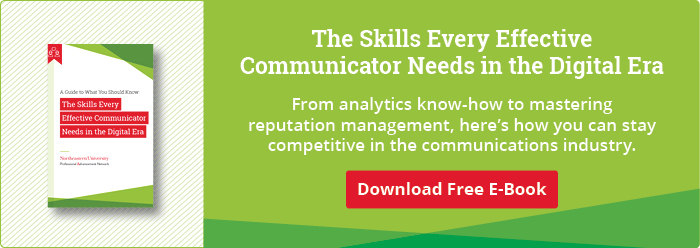In 2013, an Applebee’s server posted a picture of a patron’s bill to Reddit. The patron, a pastor, refused to tip, writing on his receipt, “I give God 10%, why do you get 18?” The story was picked up by news outlets and conversation spilled over to the restaurant chain’s Facebook and Twitter feeds.
Applebee’s later issued a statement apologizing for not keeping the patron’s personal information private and noted that it had let the employee go. Within hours, the post racked up more than 17,000 replies from people outraged that Applebee’s had fired the server. The company responded by deleting all negative commentary, which sparked additional anger.
With more than 2.8 billion people using social media, sites like Facebook, LinkedIn, Twitter, Instagram, and Snapchat have become major outlets for businesses to reach their customers on and grow their audience with.
Download Our Free Guide on the Skills Every Communicator Needs in the Digital Era
From analytics know-how to reputation management, here’s how you can stay competitive.
But key to a business’s social media success is its social media policy—an evolving document that details goals, acceptable use, and strategy, says Gladys McKie, a part-time lecturer for Northeastern’s Master of Science in Corporate and Organizational Communication program.
“The most important thing businesses can do is create a simple policy to define why they’re on social media and what they intend to do,” McKie says.
Devising sound social media policies help businesses harness the power of social media, and avoid a costly faux pas. Here’s a look at eight areas where businesses often go wrong.
1) You Don’t Appoint a Social Media Manager
Call it what you’d like: a social media assistant, social media manager, social media director—the title often depends on the size of the company. Ideally, businesses should hire someone that devotes his or her time to the organization’s social media accounts, McKie says.
“You can get into a lot of trouble if the wrong thing is said about your business,” she adds. “You want someone trained in public relations so you don’t make mistakes in answering people.”
Social media managers are tasked with developing and executing corporate social media policy, setting best practices, identifying opportunities, and engaging regularly with online audiences, according to PayScale. They should have strong communication skills, work well in a team environment, and understand analytics.
2) You Don’t Identify Why You’re on Social Media
Why do you have a presence on social media? What are you aiming to accomplish with your accounts? These are questions you should routinely ask as part of your social media strategy and spell out directly on the various outlets that you use, according to McKie.
Clearly state what your account is intended to do for the audience you’re looking to reach, she says. People want to know the purpose of the account and what to expect in following you. For example, Pepsi’s Twitter bio reads, “Enjoy a taste of Pepsi’s world with an exclusive look into music, sports, and entertainment.” The message is concise and explicit.
3) You Only Sell
Your social media accounts should feature a variety of content that your customers would find interesting. Don’t use your feeds to simply hard-sell your followers, writes Roisin Bonner, social media lead for Microsoft Canada. Purely promotional accounts—ones used only to advertise to people—turn off readers.
Successful social media campaigns should encourage followers to take action, whether that means engaging in social causes or participating in online competitions. As Bonner writes, “Get creative, think about provoking participation, not just creating awareness.”
At the same time, your posts shouldn’t all be brand-related, McKie says. If there’s news or interesting viewpoints that impact your industry or customers, consider sharing them so long as they add value.
4) You Share Too Much
Everyone has that annoying Facebook friend who posts too often and clogs your feed with irrelevant content. Brands need to be careful that they don’t become that annoying friend, according a report from Sprout Social.
While 86 percent of social media users follow a brand, nearly 60 percent of them are annoyed by too many posts from brands, its survey found.
The threshold varies from social network to social network, McKie says. For example, while you can post more frequently to Twitter than Facebook because of how quickly content turns over, a good rule of thumb is to post interesting content three to five times a day to ensure you’re not overwhelming your users.
5) You Don’t Monitor Your Feed
Ignoring what people are saying on social media—both good and bad—is dangerous, McKie says. If you’re not monitoring your social media sites several times a day, you’re missing out on opportunities to capitalize on the good and rectify the bad.
“Posts can move very quickly and not monitoring them can really destroy a business,” McKie explains.
In 2013, for example, a disgruntled customer was fed up with the way British Airways was handling the issue of his father’s missing luggage. To escalate his complaint, he purchased a Twitter ad to air his grievances, which was retweeted thousands of times. British Airways eventually responded on Twitter, saying, “Sorry for the delay in responding, our twitter feed is open 09:00-17:00 GMT. Please DM your baggage ref and we’ll look into it.” That’s a prime example of too little too late.
6) You Ignore or Delete Negative Comments
Nobody likes bad press, but in an age where information spreads like wildfire, it’s usually in the business’s best interest to address critical comments and move on.
“If someone posts a legitimate, negative comment, it’s important to answer them as best as you can,” she says. “This might mean inviting them to call you to resolve the problem.”
Tweets that are negative or critical present brands with opportunities to make a customer happy in a public setting, and allows businesses to address a problem they might not have been aware of. Of course, not all negative posts deserve attention: abusive and threatening comments should be deleted.
7) You Act Hastily
In 2014, clothing company American Apparel posted an image of smoke from an explosion to celebrate the Fourth of July. Almost immediately, people recognized the photo as the Challenger explosion and responded with shock and horror.
Even the U.S. Department of Education wasn’t spared from social media embarrassment last year when it found itself in an ironic and cringeworthy situation. It tweeted a quote from W.E.B. Du Bois: “Education must not simply teach work – it much teach life.” While an inspiring quote, they had misspelled his last name. Needless to say, people noticed.
A number of social media disasters are easily avoidable by taking a few extra moments before you hit publish, McKie says.
“If you manage a corporate account, you need to select images carefully,” McKie advises. “American Apparel, for example, could have bought an image of fireworks or used photos from Creative Commons, as long as they attributed them correctly. Taking an image off the Internet, just because it’s there, could be in violation of copyright laws.”
8) You Don’t Measure and Track Your Efforts
Demonstrating how your social media campaigns and efforts contribute to the business’s goals is key to retaining buy-in and proving your return on investment, whether that means improving brand awareness, revenue, or customer satisfaction.
Tracking your campaigns and measuring your ROI is important for several reasons. It can demonstrate the impact social has across multiple departments; help you discover where social is being used most effectively and make adjustments accordingly; and enable you to better understand your customers, their preferences, and motivations.







Related Articles
Faculty Insights: What Do Employers Look for in a New Candidate?
Virtual Co-op Evolves Into a Social Platform WomenVotes.org
Why You Should Consider a Career in Technical Writing